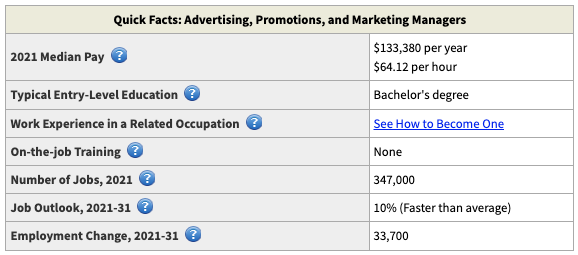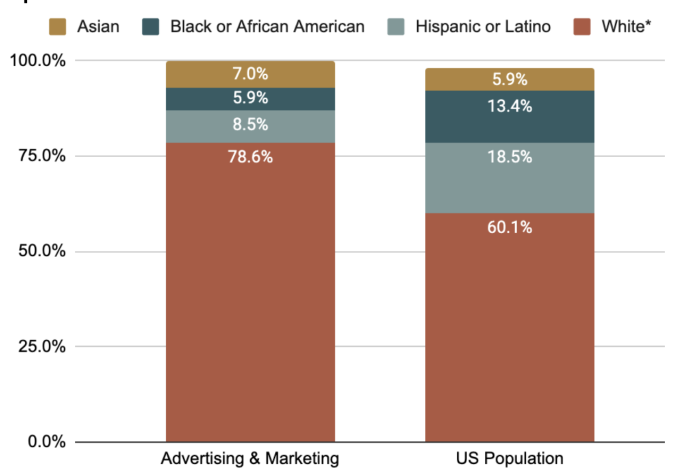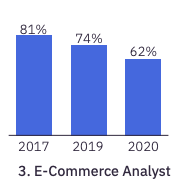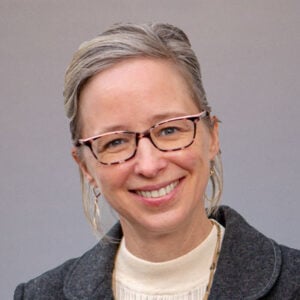Registered apprenticeship is one of the many tools we can use to address the staggering differences between wealth in white and non-white families in the United States. As an alternative to expensive college-degree requirements, Two Octobers’ apprenticeship offers a route to a lucrative and growing career path, digital marketing. We’re motivated by a belief that business has a role to play in improving society, but apprenticeship has many practical advantages for businesses challenged with workforce development.
Our digital marketing program is fairly unique in our industry, but registered apprenticeship deserves more attention in all professional industries. With secondary education systems updating curriculum to address the needs of a digital future, and college both increasingly out of reach for students, and not always providing adequate pre-employment training, apprenticeship offers a workforce development option for employers that has the dual benefit of addressing societal inequity.
The Racial Wealth Gap in the United States
“The racial wealth gap in the United States is staggering. While the median white family had about $184,000 in family wealth in 2019, the median Black family had only $23,000 in wealth and the median Latinx family had only $38,000. This inequity has roots in many factors, including discriminatory governmental policies, generational wealth transfers, and the racial wage gap, which is fueled in large part by occupational segregation.”
Racial Representation in Professional Occupations, Economic Policy Institute
Occupational segregation exists when people of different races are unevenly represented in different kinds of jobs. In the US, jobs which pay more disproportionately are filled by white men (and to a lesser extent, white women), while the lowest paying jobs are more often filled by people of color and women. (Occupational Segregation in America, Center for American Progress)
There is signficant opportunity to improve occupational segregation in professional occupations and address income disparity along the way. The Bureau of Labor Statistics defines professional occupations as including professional, scientific, and technical services and management of companies.
“On average, professionals are paid 44% more than the median wage earned by workers in all occupations. The underrepresentation of Black and Latinx workers in professional occupations is therefore an important factor in the racial wage gap.”
Racial Representation in Professional Occupations, Economic Policy Institute
People of color are underrepresented in professional occupations across the board, and we believe business needs to work harder to create pathways for people of color to employment in professional jobs.
Employment in Marketing and Advertising
As one lens on a professional career, we look at what we know, marketing and advertising. But many professional careers will share similar characteristics.
Opportunity
Advertising and marketing is an in-demand career with a faster-than-average projected growth rate.

2021 median pay for this job is listed at $133,380, three times more than the median annual wage for all workers of $45,760. (In Two Octobers’ experience, digital marketing salaries range from $35,000 to well over $100,000.) “About 35,300 openings for advertising, promotions, and marketing managers are projected each year, on average, over the decade.”
Diversity
The marketing and advertising industry is no different from many other professions; we are not diverse in any sense of the word. This is a social-economic problem, but it also affects the quality of our work. A business hires marketers to connect with all potential and current customers, but homogenous marketing teams are mostly good at connecting with people like them.

This chart compares the racial diversity of our profession to the US as a whole. People who describe themselves as Hispanic, Latino, Black or African American comprise 14.4% of advertising and marketing professionals. That same group represents 31.9% of the US population.
Anecdotally, we don’t believe our profession does any better in terms of socio-economics, abilities, military service or other measures of diversity.
Impediments to Employment
The reasons the marketing industry doesn’t employ more people of color are not unique to our industry. Historical and current bias, both conscious and unconscious, are significant contributing factors. Many employers only hire marketers with experience, and the representation of Black and Latinx declines as job seniority increases (A Diversity Report for the Marketing/Advertising Industry 2022, Association of National Advertisers).
And education levels play a role, too. The US Bureau of Labor Statistics states that “A bachelor’s degree is required for most advertising, promotions, and marketing management positions.” And fewer American adults who are Black or Hispanic have a bachelor’s degree than those who are non-Hispanic White (US Census Bureau).
The rising cost of college affects all people, but disproportionately populations with lower median household income, which may deter students from attending college altogether. (Rising Costs Making It Hard for Students, Particularly of Color, to Afford College, Center on Budget and Policy Priorities)
We do see a nationwide trend towards removing degree requirements from job postings, such as this example of the percentage of jobs requiring degrees for a position in our industry.

“Removing degree requirements spurs employers to be more specific about the skills they seek. Employers that remove degree requirements often add to the hard, technical, and soft, social skills they require or prefer for the job. As such, the degree reset does not seem to reflect any diminution in the complexity of work; quite the contrary, jobs that undergo a degree reset are more likely to specify high-level skills.”
The Emerging Degree Reset, The Burning Glass Institute, 2021.
Fewer degree requirements is a generally positive trend, offering more flexibility in career pathways. But experience and skillsets are still requirements for higher level jobs; therefore there continues to be a need for some sort of training to help all candidates be prepared for professional jobs, even if it isn’t a college degree.
Apprenticeship
We set out to improve access to digital marketing as a high-paying, in-demand career for all in a way that is focused on supporting people affected by the racial wealth gap. We chose registered apprenticeship because it is specifically structured to support many of the challenges addressed above.
Why Apprenticeship
The demand for people with current and relevant marketing skills is growing, but university programs tend to put emphasis on research skills and marketing concepts. In more than a dozen years of hiring entry-level roles, we have found that we get the best results when we provide significant training, even those with bachelor’s degrees in marketing. So we asked ourselves, if we are starting with that expectation, why do we require a degree?
The philosophy of apprenticeship switches up the education-first mindset. In an apprenticeship system, education is an essential ingredient, but it is directly connected to what workers and businesses need.
One assumption we encounter is that apprenticeships are equivalent to internships. There are similarities, but understanding how they differ is helpful towards appreciating the impact of apprenticeship.
- Applicants typically (and in our program) are recruited from workforce agencies and other organizations that have a mission to serve underrepresented groups.
- Apprenticeships are designed to lead to ongoing employment.
- Apprenticeship is a job with milestones for increases in income and responsibilities.
- Internships often act as free or low-cost labor and aren’t required to include structured training.
Read our full article on apprenticeship vs. internship for additional differences.
Why Registered Apprenticeship
The highest standard of apprenticeship is a Registered Apprenticeship, certified by the US Department of Labor. These must be paid jobs that include structured on-the-job training and mentorship as well as supplemental classroom education. The Department of Labor reviews and approves each Registered Apprenticeship program, and monitors the progress of apprentices. A nationally-recognized credential is provided upon completion. Our apprenticeship meets these rigorous standards and was among the first in our profession to offer full pay to candidates with no requirements beyond a high school diploma or GED.
Registered Apprenticeship programs include many elements to promote diversity. “Programs are designed to reflect the communities in which they operate through strong non-discrimination, anti-harassment, and recruitment practices to ensure access, equity, and inclusion.” (ApprenticeshipUSA, Department of Labor) As a result, individuals active in registered apprenticeships are more likely to be non-White (49%) than the overall population (40%).
Sponsors of Registered Apprenticeships (the term for hiring and reporting organizations like Two Octobers) are required to adhere to Equal Employment Opportunity regulations outlined for apprenticeship. The Department of Labor’s office of apprenticeship provides resources to employers about “how to comply with nondiscrimination requirements, assess any barriers to equal opportunity, broaden outreach strategies, and create the kind of diverse workplace that benefits both sponsors and apprentices.” Sponsors with more than five apprentices must have an affirmative action program.
Registered Apprenticeship is Uncommon in Professional Occupations
Registered apprenticeship is extremely uncommon in professional occupations like marketing and advertising which have stronger potential to close the racial wealth gap. In 2021 data from the US Department of Labor, apprentices in the “Professional, Scientific, and Technical Services” field represented only 3% of 593,690 active registered apprentices.
The Digital Marketing Apprenticeship at Two Octobers
Two Octobers’ digital marketing apprenticeship started in 2020 and has employed two apprentices to date in a milestone-based program that takes around three years to finish. At completion, apprentices are awarded a nationally-recognized certificate. Like most employers of apprentices, we intend to offer permanent employment for our apprentices so they can continue to contribute to our team, while continuing to grow in the profession. Read more about our digital marketing apprenticeship from the perspective of potential candidates and potential employers.
We’re proud to be able to impact the lives of individuals growing their digital marketing careers. We’re gratified that doing so has helped Two Octobers as a company incorporate more diverse perspectives in our workforce. But we can only hire so many people–there’s a lot more to do.
If you’re an employer in a professional occupation who is curious about apprenticeship, we’d love to help you explore that path. Take a look at our other apprenticeship resources, and be sure to reach out–we’d love to talk.




